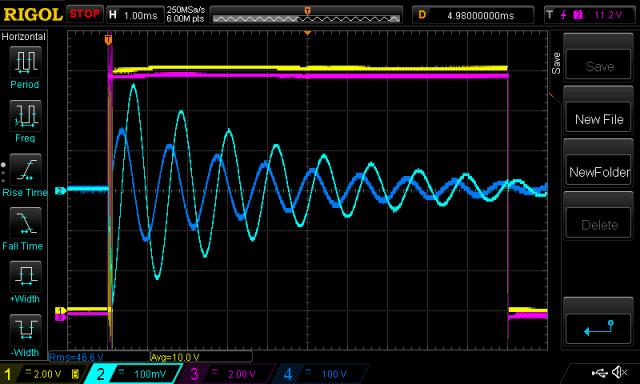Guru
Joined: 02/02/2017
Location: AustraliaPosts: 1432
| Posted: 12:12pm 03 Jul 2018 |
Part 22: Resonant frequency of the toriod/primary choke/secondary winding capacitor
Earlier this week Tinyt was looking at the EG8010 startup. When power is applied, the chip outputs 3 pulses at the 23.4 kHz and stops with both outputs of the full bridge pulled to ground. It injects a quick pulse of energy, which excites the resonance of the LC tank circuit (also known as the toriod transformer, series inductor on the primary winding and the capacitor across the 240V output winding)
Here is an example, using the 1.95uF cap.

The dark Blue is the 240V secondary voltage. You can easily see the clean oscillation
resulting from the short pulse of energy injected into the tank.
Light Blue is primary winding current.
Yellow is SPWM gate drive.
Pink is 50 Hz gate drive.
I tried 4 different capacitors and here are the results.
6.45uF gave 461 Hz
1.95uF gave 838 Hz
0.99uf gave 1,180 Hz
0.47uF gave 1,773 Hz
The resonant frequency of a LC tank circuit is given as
F (hz) = 1/ (2 x pi x sqrt(L x C))
Since the inductance is constant, the frequency varies as 1/sqrt(C)
so if we multiply the frequency by sqrt(C) we should get a constant.
461 x sqrt(6.45) = 1170
838 x sqrt(1.95) = 1170
1180 x sqrt(0.99) = 1174
1773 x sqrt(0.47) = 1215
Near enough.
The AC output waveforms do change a bit with different caps. In my situation
the 1.95uF gives me the least distorted sine wave output and the lowest
idle DC current.
I mistakenly tried it without any capacitor and the EG8010 could not run at all.
wronger than a phone book full of wrong phone numbers